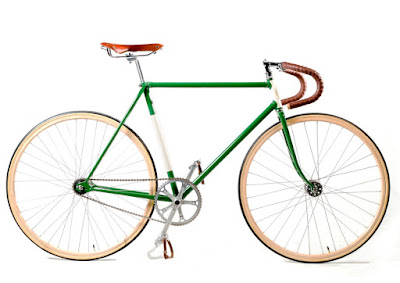"Ghostbikes" are sad, grim testimonies to the hazards we face from unaware drivers, indifferent or hostile law enforcement agents as well as misguided or uninformed planners and bureaucrats.
Now, "ghostriding" doesn't refer to riding "ghostbikes". Rather, it looks something like this:
As you can see, a person doesn't actually "ghostride" a bike. Rather, he or she guides the "ghostridden" bike with one hand and controls the bike he or she is riding with the other.
Every time I have done it, I've guided the "ghostrider" with my right hand. That makes perfect sense when you know that I am right-handed. Then again, everyone else I've seen "ghosting" a bike has also used his or her right hand. Since I don't know what percentages of cyclists are right- or left-handed (or ambidexterous), I am guessing that practice is a result of riding on the right side of the road, which is what cyclists in every country in which I've ridden-- besides the UK-- do. I'm sure I saw a "ghoster" or two during the times I was in England, but I can't recall whether they "ghosted" with their right or left hands.
I am thinking about all of this now because I saw someone "ghostriding" this morning, as I rode to work. He was astride a Cannondale mountain bike and he was "ghosting" a fixed-gear bike with dropped handlebars. In some ways, that makes sense, as the fixed-gear bike is probably lighter and thus easier to guide. Also, my own experience has shown me that it's easier to ride the bike with the more upright position and keep my arm level, or sloped somewhat downward, than to have to keep my arm in an upward position to hold the bike.
There are others, however, who would do the opposite. My guess is that they feel they have more control on a fixed-gear bike (I would agree) and that guiding the heavier and more upright bike is easier because it's more stable. Perhaps the guy in the photo (Believe it or not, I once looked something like him!) thinks the same way.
As you might have guessed, the hardest part about "ghostriding" is getting started. Once the bikes are in motion, it's somewhat more difficult than riding a single bike, but the momentum of the bikes helps to keep you going. Your main concerns, once you're moving, are in maneuvering the "ghosted" bike--especially if you are in traffic-- and in stopping with only one hand. Also, it helps to have a spot where you can easily lean the "ghosted" bike when you're ready to dismount.
I haven't "ghostridden" a bike in a while, but it's certainly easier than carrying a bike while you're riding one--something I've done, believe it or not. It's also not much more difficult than carrying a frame while you ride, at least for short distances.
Whatever way you transport your bike on a bike, it's better than that bike becoming a "ghostbike"!
Now, "ghostriding" doesn't refer to riding "ghostbikes". Rather, it looks something like this:
 |
| From Instructables |
As you can see, a person doesn't actually "ghostride" a bike. Rather, he or she guides the "ghostridden" bike with one hand and controls the bike he or she is riding with the other.
Every time I have done it, I've guided the "ghostrider" with my right hand. That makes perfect sense when you know that I am right-handed. Then again, everyone else I've seen "ghosting" a bike has also used his or her right hand. Since I don't know what percentages of cyclists are right- or left-handed (or ambidexterous), I am guessing that practice is a result of riding on the right side of the road, which is what cyclists in every country in which I've ridden-- besides the UK-- do. I'm sure I saw a "ghoster" or two during the times I was in England, but I can't recall whether they "ghosted" with their right or left hands.
I am thinking about all of this now because I saw someone "ghostriding" this morning, as I rode to work. He was astride a Cannondale mountain bike and he was "ghosting" a fixed-gear bike with dropped handlebars. In some ways, that makes sense, as the fixed-gear bike is probably lighter and thus easier to guide. Also, my own experience has shown me that it's easier to ride the bike with the more upright position and keep my arm level, or sloped somewhat downward, than to have to keep my arm in an upward position to hold the bike.
There are others, however, who would do the opposite. My guess is that they feel they have more control on a fixed-gear bike (I would agree) and that guiding the heavier and more upright bike is easier because it's more stable. Perhaps the guy in the photo (Believe it or not, I once looked something like him!) thinks the same way.
As you might have guessed, the hardest part about "ghostriding" is getting started. Once the bikes are in motion, it's somewhat more difficult than riding a single bike, but the momentum of the bikes helps to keep you going. Your main concerns, once you're moving, are in maneuvering the "ghosted" bike--especially if you are in traffic-- and in stopping with only one hand. Also, it helps to have a spot where you can easily lean the "ghosted" bike when you're ready to dismount.
I haven't "ghostridden" a bike in a while, but it's certainly easier than carrying a bike while you're riding one--something I've done, believe it or not. It's also not much more difficult than carrying a frame while you ride, at least for short distances.
Whatever way you transport your bike on a bike, it's better than that bike becoming a "ghostbike"!











